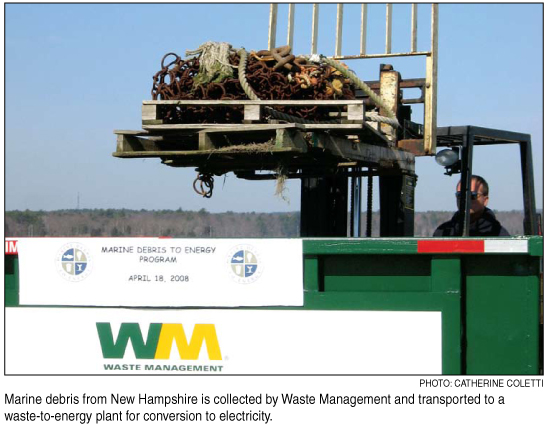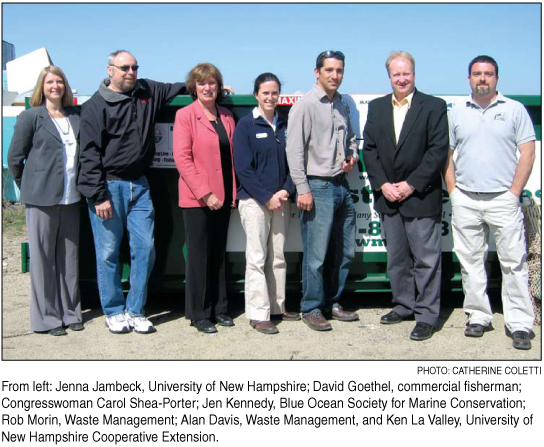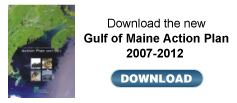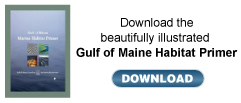Collaboration turns dangerous debris into power
By Catherine Coletti

To the unknowing observer, it might look just like any dumpster. But history is being made here at the Yankee Fishermen’s Cooperative in Seabrook, New Hampshire.
A recently formed partnership of the Blue Ocean Society for Marine Conservation, University of New Hampshire (UNH) and the Waste Management company not only keeps marine debris out of the ocean – it goes a step further to use it as an energy source.
Marine debris is one of the biggest problems facing marine life, which can be killed or hurt through entanglement and ingestion. It is estimated that thousands of fish, marine mammals and birds are impacted by debris annually.
For the first time in New Hampshire, fishermen have a place to dispose of damaged fishing gear, such as nets, rope and line, and most of what ends up here is taken by Waste Management to a waste-to-energy plant in North Andover, Massachusetts, where it’s burned to generate electricity.
Appropriately dubbed the marine debris to energy project, so far 3.38 tons (3 metric tons) of debris have been collected since last April. What cannot be processed at the plant, such as certain metals, is separated out and recycled or disposed of by Waste Management.
“The cool thing about the project is that it’s a cooperation between us and the fishermen. It’s a non-confrontational relationship,” said Blue Ocean Society for Marine Conservation Director Jen Kennedy.
The goal of the project is to get as much lost and damaged fishing gear as possible out of the water, where it poses a serious navigational hazard to fishermen and life-threatening risk to marine wildlife. Fishermen often encounter this derelict gear at sea. Prior to the project they had nowhere to put it if they pulled it up.
What may be surprising to those not familiar with commercial fishing is the sheer size of the gear. For instance, gill nets, which have vertically placed panels of 100 feet plus (30.4 meters), end up ripping out and getting into the marine environment.
“The reason I got involved with the project is that I wanted to work with the industry to mitigate impacts of gear,” said Ken La Valley commercial fisheries specialist at the New Hampshire Sea Grant, who approached the Yankee Fishermen’s Co-op about collecting used and abandoned fishing gear onsite.
Fishermen also have the unique opportunity to enter the specific latitudinal and longitudinal location of where they find the gear at sea using a website that was created as part of this project.
Wave action often causes long lines, nets and bulky gear to mesh together, creating a mass that lies in wait to ensnare a fishing boat or unsuspecting marine mammal. In 2007, the Provincetown Center for Coastal Studies confirmed 30 cases of entangled whales in Northeast U.S. and Canadian waters.
Atlantic Large Whale Disentanglement Network members work together to free whales from the life-threatening gear. However this process is extremely dangerous for humans and not all reported wildlife is able to be rescued or even relocated.

During the summer of 2007, Dr. Jenna Jambeck of UNH and Kennedy worked together on a survey to analyze where debris was coming from with the goal of developing improved outreach and prevention strategies. Jambeck was surprised by the high amounts of ocean-based debris recorded in New Hampshire, noting that more ocean-based debris was recorded on International Coastal Cleanup Day data cards in New Hampshire than in Florida.
The missing link: fishermen.
Jambeck and Kennedy partnered with La Valley, who has served as a point of contact to fishermen throughout the project. Then, enter Waste Management, which donated both the dumpster and removal services, and Wheelabrator Technologies, a subsidiary of Waste Management that makes its business turning trash into energy.
This A-team received a grant from the National Oceanic and Atmospheric Administration’s (NOAA) Marine Debris Grants Program to conduct the project. The project has funding through February and partners are currently looking for additional grant funding to continue.
Fishermen at the Yankee Co-op say they are happy to finally have a place to dispose of damaged gear and derelict gear found at sea. However, curbing general dumping on nights and weekends when co-op members are not there, remains a challenge. La Valley is hoping the new lockable dumpster lid will do the trick.
Another part of the project is monofilament bins placed at five locations throughout the seacoast, targeted to recreational fishermen. Monofilment takes 600 years to break down in the environment, and in the meantime can continue to kill and injure plenty of marine wildlife.
CSI Debris
Nobody knows for sure how much derelict fishing gear lies beneath, but La Valley predicts that it must be an astounding amount based on the day he spent out mapping it using a multi-beamed sonar in Portsmouth Harbor.
Where it all comes from is now being recorded into a database into which anyone can enter data via a website that is quickly becoming the data collection point for marine debris reporting. Further website development is underway, and users will soon be able to generate reports and maps detailing what types of debris have been found where. The educational possibilities are endless. For instance, teachers will be able to take students on a cleanup and see the results on a map.
Massachusetts is doing a similar campaign called “fishing for energy.” Other projects outside the region are happening on the West Coast. Kennedy hopes that this project will become a model for others in the Gulf of Maine region.
To learn more, go to the New Hampshire Marine Debris to Energy Project Web site.
[ back to top ]
|








